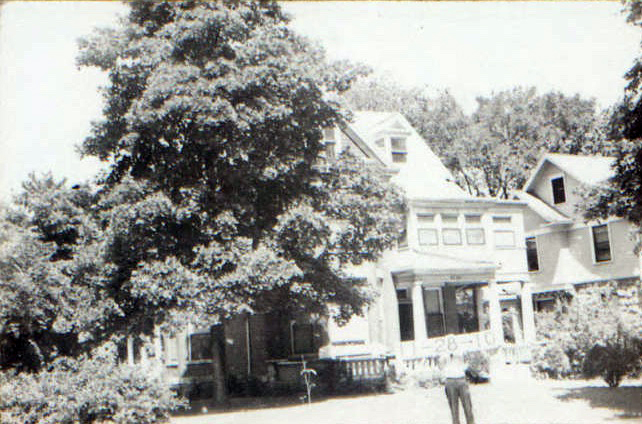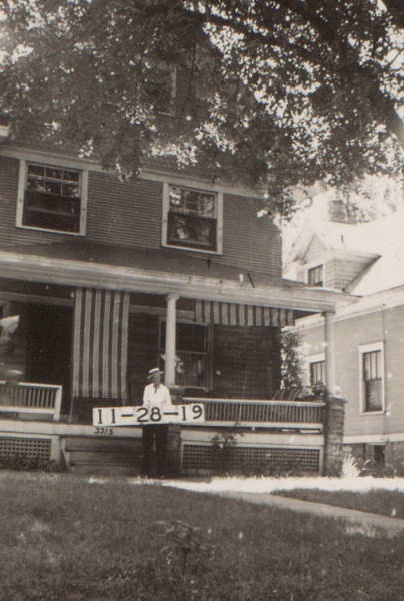
Like many neighborhoods in Kansas City, the large homes on this North Hyde Park block (from Charlotte to Campbell between 33rd and 34th) suited the extended families, servants, and boarders who lived there at the turn of the 20th century. Over the next few decades, families often moved on to smaller homes or the modern new residential hotels, and some of the homes became rooming houses.
As new residents moved in during the 1970s and 1980s, neighborhood residents often disagreed over the best use of the homes. Some favored single-family residences, while others saw the income potential of multiple apartments.
As part of our Uncovering History Project, the Midtown KC Post is examining each block in Midtown. A set of 1940 tax assessment photos is available for many blocks.
Today, the block bounded by Charlotte and Campbell between 33rd and 34th Streets.

A 1909-1950 Sanborn map of the block.
In 1910, an advertisement in the Kansas City Star offered a new home for sale in North Hyde Park at 3324 Campbell.
“10-room modern solid pressed brick; built by day labor for a home; complete in every respect; large rooms; high ceilings; hardwood floors; mantels and grates; combination furnace; large stone and granitoid front and side porches; lot 50 x 60 feet; trees and shrubbery; large barn; convenient to Westport High school, churches, and 3 car lines.”
The new home was part of Kansas City’s march southward as residents moved from downtown and spread out in the newly developing Hyde Park area. Early property maps show only two houses on the block before 1900: 3312 and 3334 Campbell. But the area developed quickly: By 1907, the block had been completely filled with homes.

One of the early homes on the block was 3312 Campbell. In 1910, the residents were selling chickens, and that same year, they were offering three rooms in the home for rent. By 1930, the home had been converted into apartments. By 1981, the Hyde Park Neighborhood Association had placed the restored 1897 Queen Anne on its homes tour, highlighting its history.
Some of the residents in 1910 included city officials such as city treasurer Frank E. Moorehouse at 3305 Charlotte. His family lived in the home until at least 1930. Dentist Jerome Stuart and his wife Olive lived at 3326 Campbell with a mulatto maid named Jessie Williams, one of several families with black or white servants through the 1930s. German immigrant and widow Henrietta Goldman, two sons and a daughter made their home at 3316 Campbell, while next door at 3312, two households: civil engineer Elmer Harper, his wife Aurora and a son; and widow Mary Leitch, a public school teacher, two daughters, and a son, showed up in the 1910 census. There were also families whose breadwinners worked for the railroad, such as railroad conductor John Hall, his wife Josephine, a son and two daughters at 3300 Campbell, and another conductor, Orson Smith, his wife Maude, four daughters and two sons at 3301 Charlotte.

In the 1920s, Charles C. Davis was the world champion horseshoe pitcher and was inducted into the National Horseshow Pitchers Association Hall of Fame in 1968. Davis began pitching horseshoes when he was young, and the game was known as barnyard golf. He was said to have revolutionized the game. In 1972, Davis lived in this home at 3322 Campbell.
In the 1920s, several families headed by railroad workers still lived on the block, joined by those headed by a doctor, an Irish-born grocer, a car salesman, a telephone company clerk, and a city inspector. The Charles Parsons family at 3311 Charlotte had five sons and a daughter, but most households consisted of parents, about two children and often a widowed grandmother or other extended family member. A decade later, according to the 1930 census, several of the homes housed more than one household, and one at 3328 Campbell was a boarding house with 14 lodgers who worked as seamstresses, clerks, stenographers, and typists.
The block became the focus of neighborhood restoration efforts in the 1980s. In 1981, the Hyde Park Neighborhood Association was fighting an absentee landlord at 3300 Campbell, claiming he had allowed the converted apartment house to deteriorate. They argued the house was pivotal to the block’s redevelopment. The following year, they told the city they wanted to shore up the neighborhood’s residential character by opposing apartments at 3316, 3322, and 3324 Campbell.
The photos below show the rest of the homes as they looked in 1940.
Historic photos courtesy Kansas City Public Library/Missouri Valley Special Collections.
















North Hyde Park sits a short drive north of Country Club Plaza, one of the most popular shopping centers in the city. Locals visit for brands like Michael Kors, Burberry, Lululemon and Tiffany and Co. If you prefer to shop at boutique clothing stores, check out Normal Human. This apparel store specializes in designing their own T-shirts and tank tops for men and women. They also carry neckties, jewelry, journals and soap, all of which are locally made.